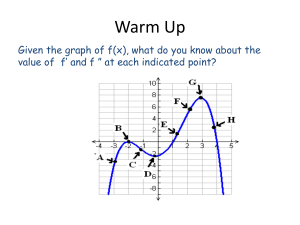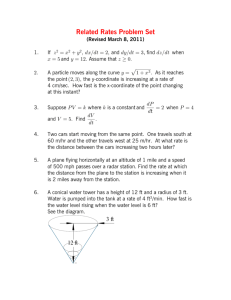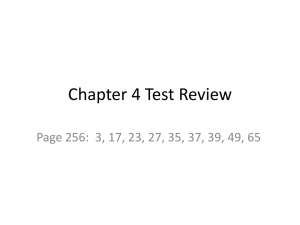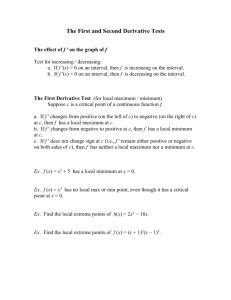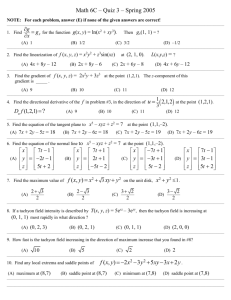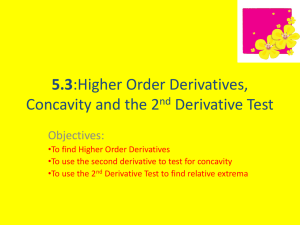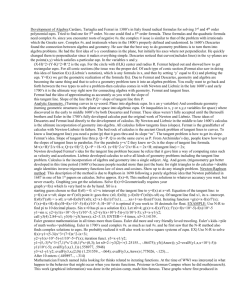Solutions to Sample Test
advertisement
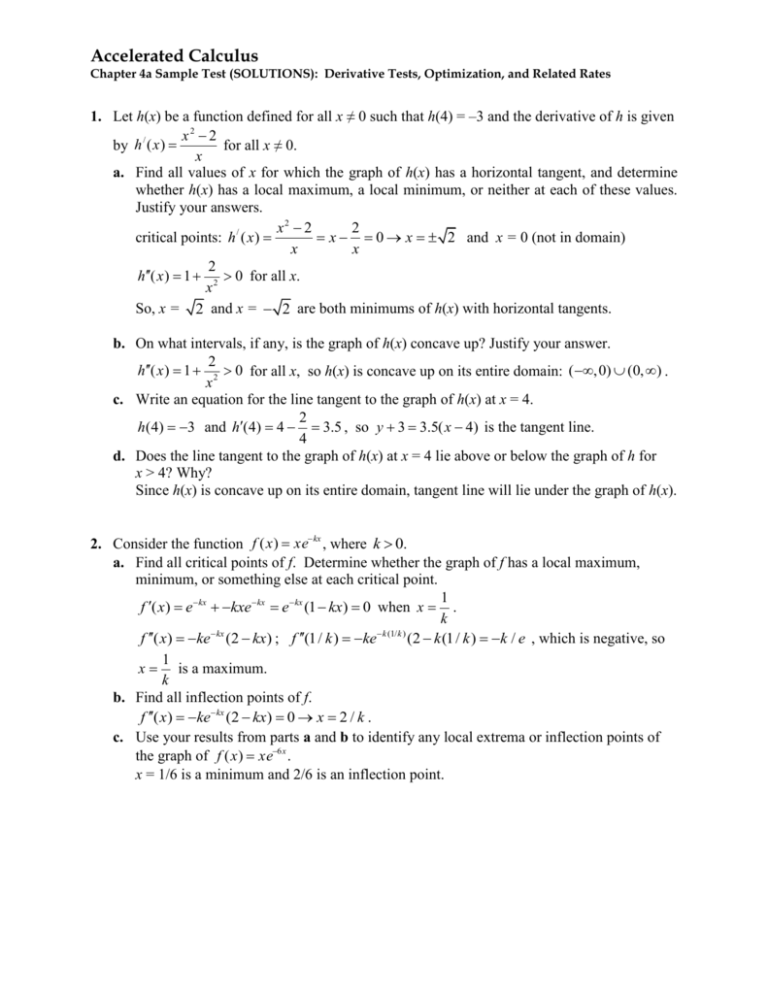
Accelerated Calculus Chapter 4a Sample Test (SOLUTIONS): Derivative Tests, Optimization, and Related Rates 1. Let h(x) be a function defined for all x ≠ 0 such that h(4) = –3 and the derivative of h is given x2 2 by h / (x) for all x ≠ 0. x a. Find all values of x for which the graph of h(x) has a horizontal tangent, and determine whether h(x) has a local maximum, a local minimum, or neither at each of these values. Justify your answers. x2 2 2 critical points: h / ( x ) x 0 x 2 and x = 0 (not in domain) x x 2 h( x ) 1 2 0 for all x. x So, x = 2 and x = 2 are both minimums of h(x) with horizontal tangents. b. On what intervals, if any, is the graph of h(x) concave up? Justify your answer. 2 h( x ) 1 2 0 for all x, so h(x) is concave up on its entire domain: ( ,0) (0, ) . x c. Write an equation for the line tangent to the graph of h(x) at x = 4. 2 h(4) 3 and h(4) 4 3.5 , so y 3 3.5( x 4) is the tangent line. 4 d. Does the line tangent to the graph of h(x) at x = 4 lie above or below the graph of h for x > 4? Why? Since h(x) is concave up on its entire domain, tangent line will lie under the graph of h(x). 2. Consider the function f (x) xekx , where k 0. a. Find all critical points of f. Determine whether the graph of f has a local maximum, minimum, or something else at each critical point. 1 f ( x) e kx kxe kx e kx (1 kx) 0 when x . k kx k (1/ k ) f ( x ) ke (2 kx ) ; f (1 / k ) ke (2 k (1 / k ) k / e , which is negative, so 1 x is a maximum. k b. Find all inflection points of f. f ( x ) ke kx (2 kx) 0 x 2 / k . c. Use your results from parts a and b to identify any local extrema or inflection points of the graph of f (x) xe6x . x = 1/6 is a minimum and 2/6 is an inflection point. Accelerated Calculus Chapter 4a Sample Test (SOLUTIONS): Derivative Tests, Optimization, and Related Rates 3. Consider the graph of g ( x ) , given at right. Determine the location of all relative extrema and inflection points of g on the interval [−4, 4]. Local Maximum: x = 4 Local Minimum: x = −4 Inflection Points: x = −3, −1, 1, 3. 4. For what value(s) of x does the tangent line to the curve y 1 40 x3 3x5 have the largest slope? All conclusions must be fully justified using calculus-based techniques. The slope of the tangent line is given by m 120 x 2 15 x 4 . m achieves a maximum when m 240 x 60 x 3 0 x 0 or x 4 . m( x) 240 180 x 2 ; m(0) 240 (min) and m(4) 2640 (max). So, at x 4 the slope of the tangent to y 1 40 x3 3x5 is greatest. 5. A 13-foot ladder is leaning against a wall when its base starts to slide away. By the time the base is 12 feet from the house, the base is moving at the rate of 5 ft/sec. a. How fast is the top of the ladder sliding down the wall at that moment when the base is 12 feet from the house? x 2 y 2 132 dx dy dy dy 2x 2 y 0 ; 2(12)(5) 2(5) 0 12 dt dt dt dt R ft/sec. Therefore, the top of the ladder is sliding down the wall at a rate of 12 ft/sec when the base is 12 ft from the house. Wall Ladder Ground b. At what rate is the area of the triangular region R changing at that moment? 1 A xy 2 dA 1 dy 1 dx dA 1 1 x y ; (12)( 12) (5)(5) 59.5 ft 2 / sec dt 2 dt 2 dt dt 2 2 Therefore, the area is decreasing at a rate of 59.5 square ft/sec when the base is 12 ft from the house. Accelerated Calculus Chapter 4a Sample Test (SOLUTIONS): Derivative Tests, Optimization, and Related Rates c. Make an accurate graph of Area of R versus Distance from wall for distances between 0 and 13 feet. 1 A x 169 x 2 2 d. Where is the area of R greatest? Justify your response. x ( 2 x ) A 169 x 2 0 2 169 x 2 84.5 x 2 , x 84.5 9.192 6. For smooth (i.e. continuous and differentiable on its domain) functions, determine whether each of the following statements are True or False. a. If a(2) 0 and a(2) 3 , then a( x) has a local maximum at x = 2. False. It would be a minimum. b. If b( x ) has an inflection point at x = 0, then b( x ) +2 also has an inflection point at x = 0. True c. If d ( x ) has a local minimum at x = −2, then d ( x) 0 . False. d ( 2) could be 0 and still be a minimum. Accelerated Calculus Chapter 4a Sample Test (SOLUTIONS): Derivative Tests, Optimization, and Related Rates 7. Ship A is traveling due west toward Lighthouse Rock at a speed of 15 km/hr. Ship B is traveling due north away from Lighthouse Rock at a speed of 10 km/hr. Let x be the distance between Ship A and Lighthouse Rock at time t, and let y be the distance between Ship B and Lighthouse Rock at time t, as shown in the figure below. a. Find the distance, in km, between Ship A and Ship B when x = 4 and y = 3. Distance between Ship A and Ship B is 5 km when x = 4 and y = 3. b. Find the rate of change, in km/hr, of the distance between the two ships when x = 4 and y = 3. x2 y2 d 2 dx dy dd 2x 2 y 2d dt dt dt dd dd 6 km/hr ; dt dt Therefore, the distance is decreasing at a rate of 6km/hr when x = 4 and y = 3. 2(4)( 15) 2(3)(10) 2(5) c. Let θ be the angle shown in the diagram below. Find the rate of change of θ, in radians per hour, when x = 4 and y = 3. y dd d dy sin d cos , so d sin( ) y and ; d dt dt dt 3 4 d d 17 ( 6) 5 10 radians/hr 5 5 dt dt 5 Therefore, the angle shown is increasing at a rate of 17/5 radians/hr. sin( )
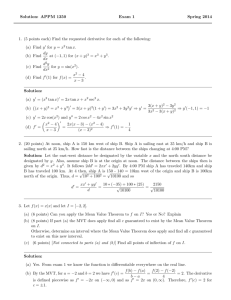

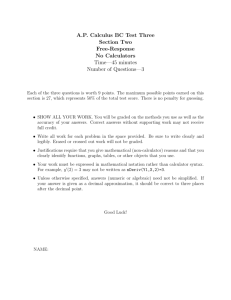
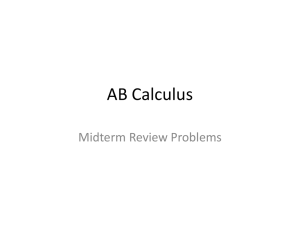

![Inflection points [4.2]](http://s2.studylib.net/store/data/005711558_1-7e6caa30b78ed23b978b40c18112cd02-300x300.png)
